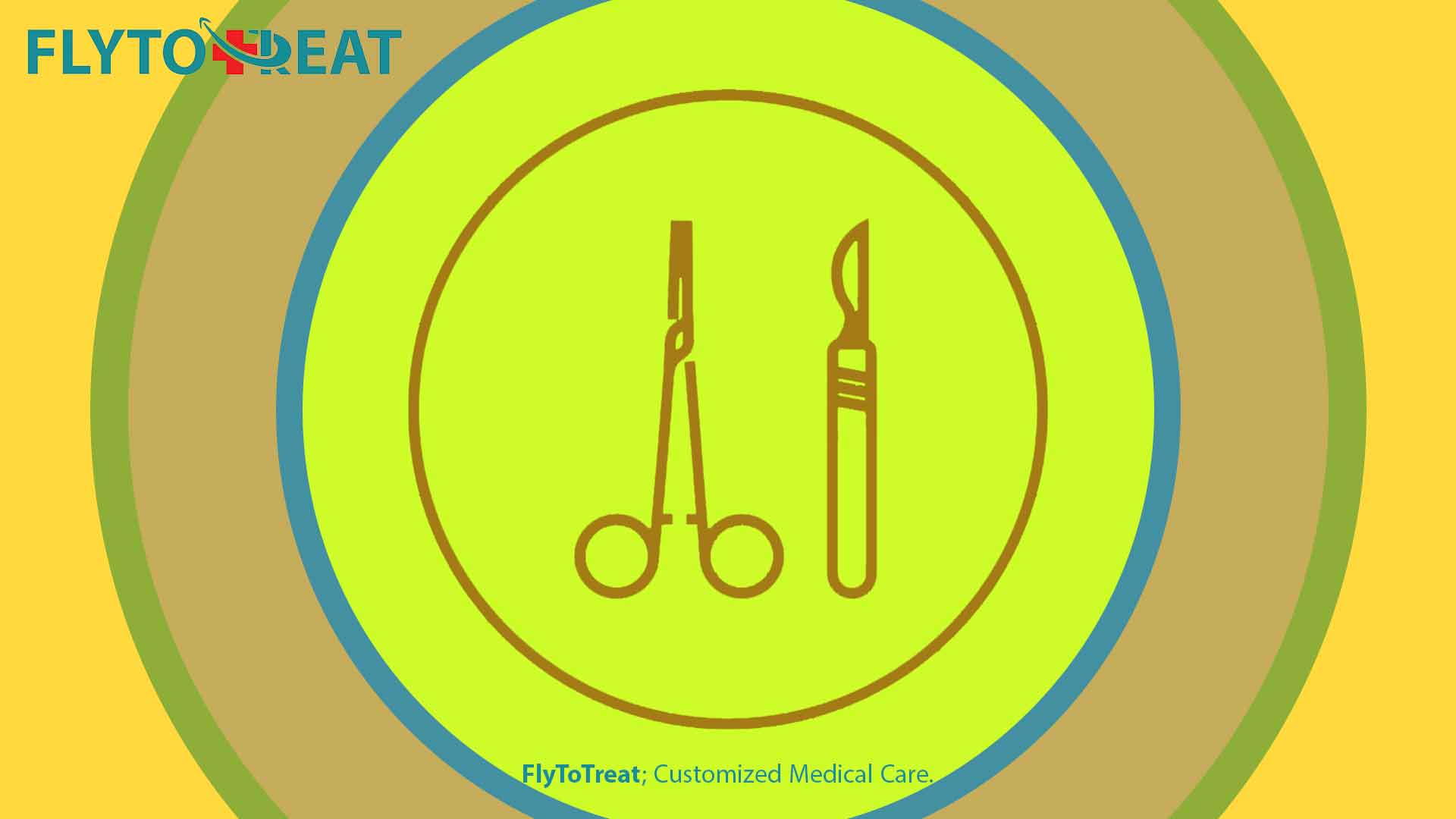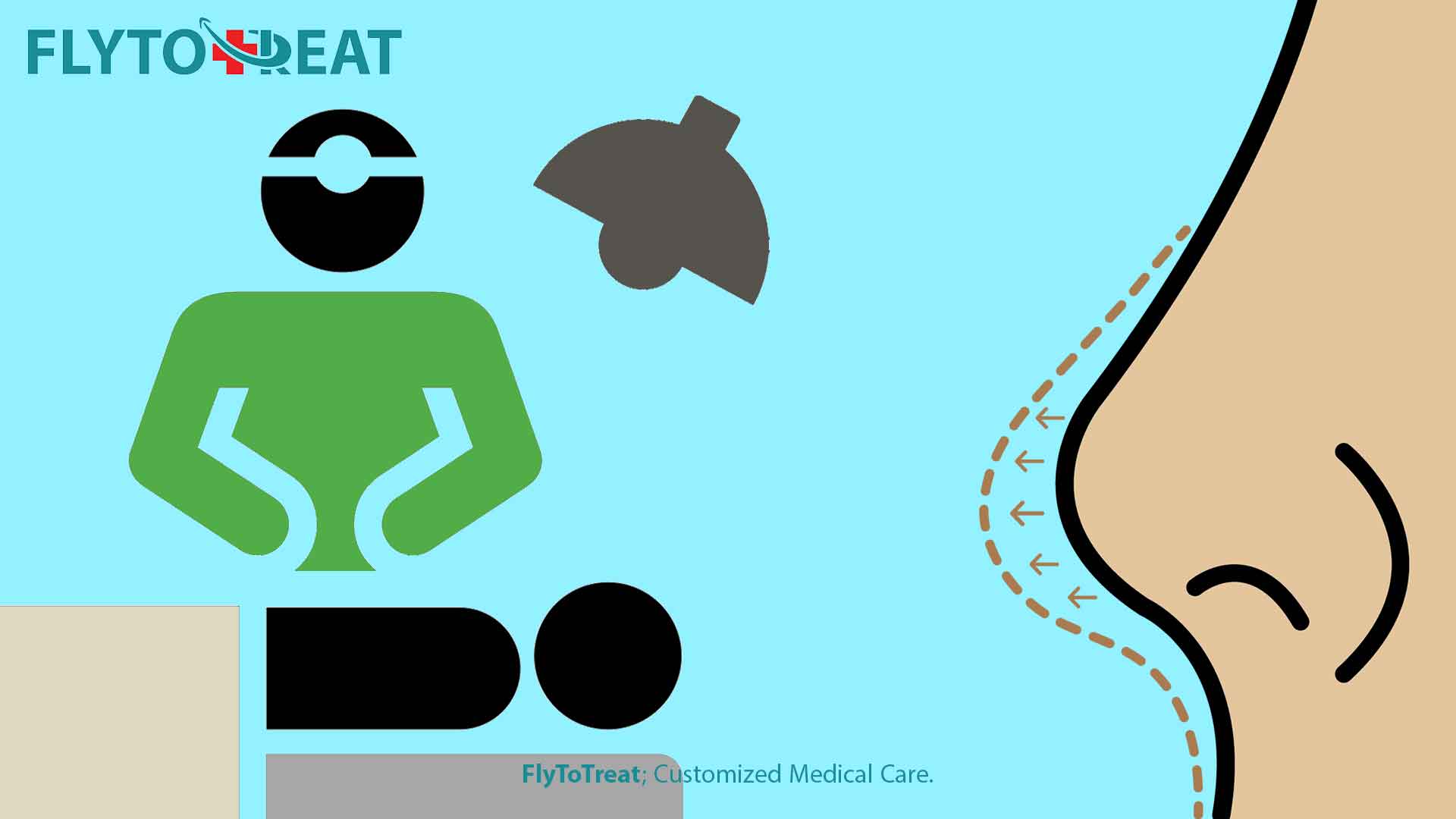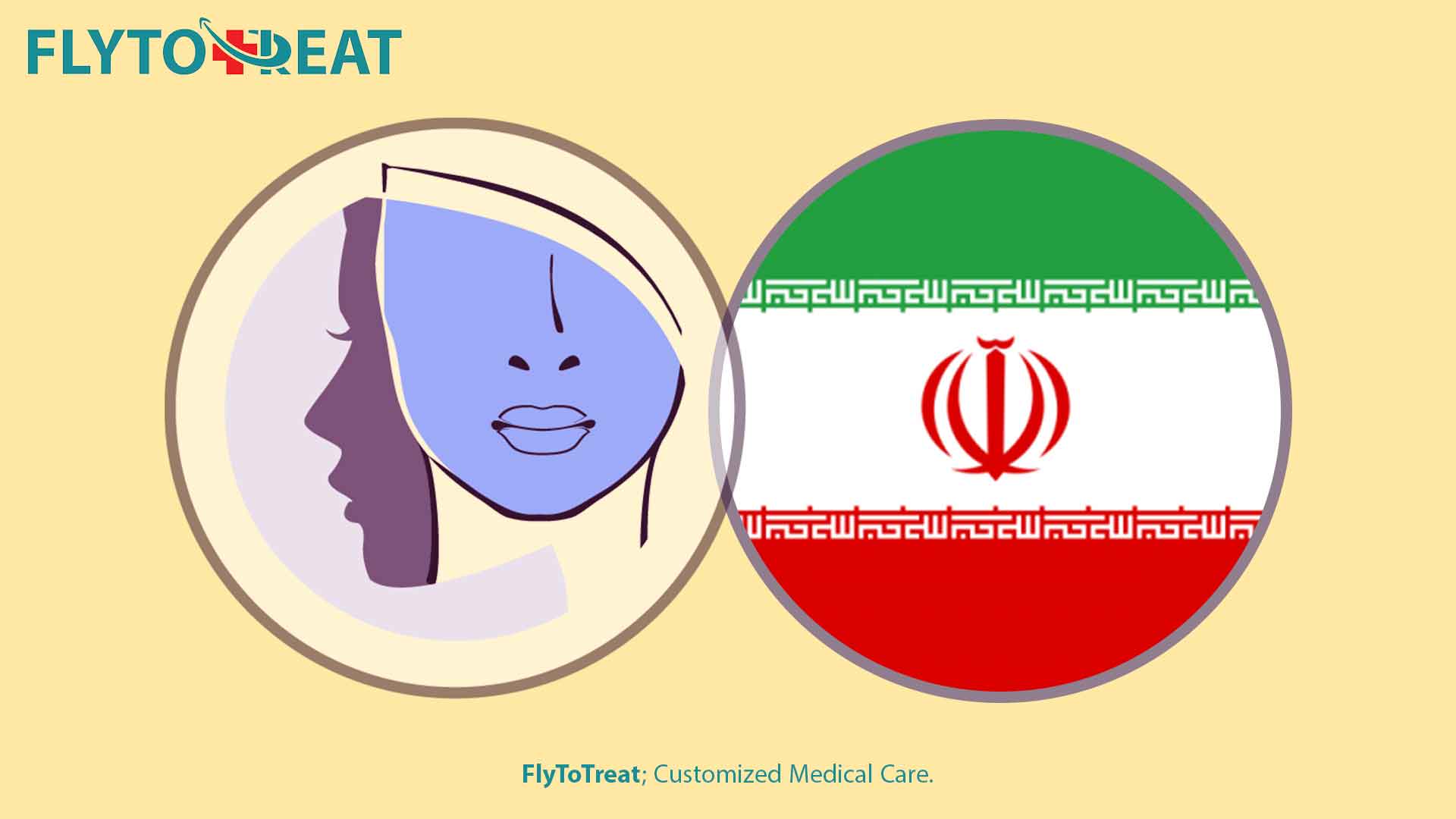
Rhinoplasty in Iran
Rhinoplasty Surgery
Rhinoplasty, also known as a "nose job" or "nose reshaping," changes the shape of the nose. Rhinoplasty may be performed for various reasons. For example, if you want to improve the harmony of your face and the proportions of your nose, this surgery is the best option. It can also help people who have difficulty breathing due to structural problems with their nose.
In recent decades, Rhinoplasty in Iran has been one of the most common reasons for international patients to travel to this country, which occurs for various reasons such as the presence of skilled and experienced Iranian surgeons and very reasonable treatment prices.
What can Rhinoplasty treat?
- Nose size to achieve a balanced face
- Nose width at the bridge or in the size and position of the nostrils
- Huge humps or depressions on the bridge of the nose.
- An enlarged or bulbous nasal tip, drooping, tilted, or hooked nose
- Nasal asymmetry
Suppose you have considered a more symmetrical nose. In that case, you must remember that everyone's face is not perfectly balanced to some degree. Due to this, the outcome of your surgery may not be utterly symmetrical. However, you have to set a goal to correct proportion and create facial balance. The following are some ways to do so:
- Make your nose smaller (nose reduction) by removing cartilage and bone.
- Make your nose larger (nose augmentation)—by taking cartilage from the ears and bone from the hips, elbow, or skull and using it to build up the nose (known as a "graft").
- By breaking the nose bone and rearranging the cartilage, you can change the shape of your nose (including the nostrils).

Do I Have a Bony Nose or Fleshy Nose?
The structure of the bones in bony noses is visible due to the thin skin that covers them. These noses typically have more cartilage, resulting in a firmer nasal tip with minor drooping.
Due to their thick skin, fleshy noses cannot offer any facts regarding their skeletal structure or cartilage. In addition, the cartilage on fleshy noses is thinner and weaker.
Although this is not always the case, a bony nose can have thick skin, and a fleshy nose can have thin skin firm cartilage.
How Differ a Bony Nose Surgery from a Fleshy Nose Surgery?
Rhinoplasty is performed differently for a fleshy nose and a bony nose. In meaty nose procedures, reshaping the tip of the nose is complicated. In fleshy nose surgery, straightening the sides of the nose and contouring the tip of the nose can result in positive outcomes.
Because of the chance of deformity of the lower part of fleshy noses after rhinoplasty due to weak cartilage and thick skin, advanced techniques are used to support the nasal tip and retain it from having to drop.
Changes in structure will significantly impact the look of bony noses. Unlike meaty noses, bony nostrils are relatively less fleshy under the skin. After surgery, those with bony noses will endure more minor swelling than those with fat noses.
Asymmetrical results are inevitable when boney noses necessitate the surgeon's utmost attention. Choosing an experienced and trained surgeon is the most crucial step to getting boney nose surgery or meaty nose surgery.
In detail, it can be said that Iranian surgeons have a particular skill in performing rhinoplasty. Due to the popularity of rhinoplasty in Iran, Iranian surgeons have been able to gain a great deal of experience in performing fleshy and bony nose surgeries.
Men and Women With Different Nose Models
As a first consideration, gender is taken into account during rhinoplasty. Masculinity is defined by prominent and angular features, whereas softer and smoother parts define femininity.
Rhinoplasty for men is typically performed to create a solid and straight bridge and a broad nose. For men, a particular model at the tip of the nose generally is unnecessary. Despite the roundness of the nose's direction, the cartilaginous edges of the nose's direction in men are often easier to see than those in women.
A nose should make a person feel confident while balancing the chin and facial features. A beautiful nose is sometimes associated with confidence, power, and a boost in attractiveness.
There is also a set of gender-neutral. Due to the upper two-thirds of the nose having a rounded, slightly wider tip, this nose has feminine and delicate aspects. These noses are still attractive despite being less masculine.
Women have a more comprehensive range of nose models to choose from, so their nose models can be tailored to complement their appearance. Many of them appear gentle and soft, and the nose requires beautiful lines and a precise distance.
Rhinoplasty generally aims to improve the shape, width, oblique and forward angles, and oblique and bold curves of the lower nasal bones so that they blend more seamlessly with the face, brows, and forehead. Women who have a shorter nose with slightly rotated tips appear more attractive.

Who is the Right Candidate for a Rhinoplasty?
Women have traditionally been at the forefront of many cosmetic operations for a long time. In fact, nose treatments were among the top five cosmetic surgeries globally.
It is vital to highlight that such procedures cannot be performed on patients who do not have a wholly grown nose. Typically, the age limit for girls is roughly 15 years old and 16 years old for boys. Before undergoing nose surgery, the patient should also demonstrate multiple maturity levels.
Although the possibilities for this sort of surgery are limitless, the patient must also have realistic expectations. Perfection is plainly a subjective concept that is unlikely to be attained. However, this does not exclude the results from being as near as possible.
What Types of Rhinoplasty Surgeries Are Performed in Iran?
The majority of surgical operations are based on the person and the approach used by the surgeon. Although the classification is the same, the technique always decides the patient's desired outcome and anatomy. In Iran, nose jobs can be classified into the following categories:
The first two operations are the most important, and the others build on them.
-
Open Rhinoplasty:
The Iranian nose job specialists incise the exterior skin between the nostrils to access the internal nose during open rhinoplasty. With access to the complete nasal structure, your surgeon has more leeway in reshaping it.
Many people are uncomfortable with the concept of having actual incisions on their noses. Still, surgeons go to great lengths to reduce scarring so that it is not visible.
-
Closed Rhinoplasty:
When you choose a closed rhinoplasty, the surgeon incisions from within the nostrils to hide your scars, this type of nose job surgery is appropriate for patients who do not need sophisticated correction of the lower regions of the nose or work on the nasal tip.
-
Tipoplasty:
Tip plasty is only performed to alter the nose's nip. If you want to modify the bridge of your nose, you can't only do tip plasty. This technique can be both open and closed.
-
Filler injection Rhinoplasty:
Because the surgeon reshapes the nose with filler, this is the least invasive rhinoplasty procedure. Some people dismiss the procedure as surgery because there are no incisions or stitches.
The two main drawbacks of this operation are that fillers do not stay as long as actual surgery, and they cannot reduce the size of the nose.
All Nose Style Is Performed in Iran
-
Natural Nose Job
Natural rhinoplasty results in a nose with a straight nasal bridge rather than a curved one, resulting in modest nose improvements. A 'natural' nose job also does not have a large gap between the nose and the upper lip.
-
Natural Nose Style for Bony Noses
The tip and bridge of a bony nose fashioned in a "natural" manner are not overly curled, and the nasal tip is not turned up (so-called retroussé noses).
-
Natural Nose Style for Fleshy Noses
For fat noses, a natural-looking rhinoplasty is frequently preferable.
-
Dolly Nose Job Also Called Fancy Nose
In Iran, 'fancy' nose jobs, sometimes known as "doll noses", are widespread, in which the nose is shortened and upturned (also known as a ski jump' nose or a snub nose).
It produces a pleasant result, which is incredibly successful in bony noses and petite faces and is most appealing in charming looks.
-
Semi-fancy Nose Job
A "semi-fancy nose job" is a style that falls in between "natural" and "fancy." The bridge is more curled than on a 'fancy' nose, and the angle between the lips and the nose is narrower.
What Should I Look For in a Surgeon?
- You should look for a specialist who frequently performs rhinoplasty.
- A training and board certification in facial plastic surgery or otolaryngology are appropriate points to note.
- An expert in rhinoplasty may have published papers in medical literature related to rhinoplasty expertise.
- Ensure that your surgery will occur in an approved surgical center or hospital.
- You should feel safe with your surgeon.
- Look for a surgeon who can clarify what will happen during your surgery in simpler words.

Techniques of Rhinoplasty
-
Rhinoplasty to Correct A Deviated Septum
A deviated septum is a nasal passage constriction that can make breathing difficult. A deviated septum is caused by crooked or off-center cartilage and bone in the area between the nostrils.
A deviated septum can be slightly inconvenient or severe enough to cause substantial breathing problems, depending on the degree of misalignment.
It is estimated that approximately 80% of all people have some degree of misalignment, and the majority are unaware of it.
So it seems to reason that cosmetic nose surgery would instantly solve concerns caused by a deviated septum, right? Wrong! Follow the instructions in the article to find your solution.
-
Septoplasty vs. Rhinoplasty
Rhinoplasty does not fix a deviated septum; however, it can be coupled with septoplasty. A septorhinoplasty is used to describe the combination of the two surgeries.
By combining these procedures, patients benefit from improved breathing and a more attractive nose. Patients can save money by having both treatments done simultaneously because expenses such as facility costs, surgeon fees, and anesthesia are split between the two procedures (with insurance covering septoplasty).
Another advantage is that adding septoplasty to a rhinoplasty treatment does not require a patient to stay in the hospital for an extended period. Most patients can resume regular physical activity within two weeks of having a septorhinoplasty operation.
-
Functional Rhinoplasty: A New Concept in Nasal Surgery
The nose is crooked or stenotic, resulting in an unappealing appearance and poor function. In this case, the boundary between septoplasty and rhinoplasty becomes blurred.
Functional rhinoplasty is essential in these circumstances. Straightening the nose, opening the airways, and straightening the septum are all tasks for the surgeon. The bridge of the nose is the top of the septum of a crooked nose. If the septum is crooked, it cannot be fixed without straightening the nose.
To make matters even more complicated, the septum may be straight at times, yet the airways are tiny, and breathing is blocked. The constriction in these circumstances is frequently caused by stenosis of the internal or exterior nasal valves.
Nasal valve surgery is required to open the nasal valves, which is generally accomplished by inserting stabilizing grafts from the patient's septum, ear, or, in severe cases, rib. This is often referred to as "functional rhinoplasty."
Iranian rhinoplasty specialists are experienced at correctly diagnosing underlying issues and knowing what will address them. Few patients can precisely assess what is required to fulfill their cosmetic and functional goals.
A comprehensive evaluation of the exterior and inside of the nose, followed by establishing realistic surgical goals, lays the foundation for satisfying results in superior patient satisfaction.
What Is the Best Way to Prepare for A Nose Job?
You must consult with your surgeon before scheduling rhinoplasty to discuss any difficulties that may arise and to determine if the procedure is likely to perform well for you. The following items are usually addressed in this meeting:
-
Your medical background: Include any history of nasal obstruction, surgeries, and drugs you are currently on. You may not be suitable for rhinoplasty if you have a blood issue, such as hemophilia.
-
Get a lab test: Your doctor will perform a thorough physical analysis and laboratory testing, such as blood tests. Your surgeon will also look at your facial characteristics as well as the inside and outside of your nose.
-
To discuss your situation: Based on your physical examination, your doctor will assess what changes you require. The thickness of your skin and the strength of the cartilage at the tip of your nose are both essential elements in the outcome. Another thing to consider is the effect of rhinoplasty on your breathing.
-
Photographs: Your doctor's office will take images of your nose from various angles. Some surgeons use computer software to modify the pictures to show you the many feasible outcomes. Your doctor will use these images for before-and-after comparisons, reference during surgery, and long-term reviews. Most significantly, the photographs allow for a focused discussion of the surgery's objectives.
-
A discussion of your goals: Discuss your intentions and expectations with your doctor. They will clarify what rhinoplasty can and cannot do for you, as well as the potential outcomes.
-
Additional surgery: If you have a small chin, your surgeon may offer chin augmentation surgery to you. This is since a small chin gives the appearance of a larger nose. Chin surgery is not essential in some cases, but it may help balance the facial profile.
Rhinoplasty Aftercare
Rhinoplasty operations are conducted as outpatient treatments. This implies that you will go home on the same day as your operation and be conscious of home aftercare. Our client coordinators and surgeons will provide you with various resources to help you navigate this procedure in Iran.
Relax a bit for the first one or two weeks, depending on the type of rhinoplasty you have. If there are any medications involved, be sure you follow the instructions strictly.
If you want to know more about nasal structure, please contact us immediately.
Medication and Food
- Avoid consuming aspirin or ibuprofen-containing drugs for two weeks before and after surgery. These drugs have the potential to enhance bleeding.
- Only take medicines that have been approved or prescribed by your surgeon.
- Avoid herbal medicines and over-the-counter vitamins as well.
- Stop smoking if you smoke. Smoking decreases the healing process after surgery and increases your risk of infection.
What Can I Predict About the Result?
Rhinoplasty doesn't quite follow a set sequence of actions. Every surgery is original and tailored to the exact anatomy and aspirations of the patient.

Secondary Rhinoplasty
Some initial operations may require changes, corrections, or modifications due to the complexity of rhinoplasty surgery. A surgeon may be necessary to conduct a revision in such a circumstance, commonly known as secondary rhinoplasty. The procedure could be open or closed depending on the predicted new aim.
During the Rhinoplasty
-
Anesthesia: Rhinoplasty necessitates either local anesthetic with sedation or general anesthesia, depending on the nature of your procedure and your surgeon's preference.
-
Procedure: Rhinoplasty involves surgery inside the nose or via a small cut (incision) between the nostrils at the base of the nose. The surgeon will most likely realign the bones and cartilage beneath your skin.
-
Style: Your surgeon can modify the nasal bones or cartilage shape in various ways. There are many factors to consider, such as how much needs to be removed and available materials.
-
For small changes: The surgeon may remove cartilage from your ear or deeper within your nose.
-
For larger changes: A surgeon can use cartilage taken from your rib, implants, or bone taken from other parts of your body. As soon as the changes have been made, the surgeon stitches the incisions in your nose and replaces the nose's skin and tissue.
-
Improve breathing: The surgeon can also correct a deviated septum (a wall that separates the two sides of the nose) to improve breathing.
-
Recovery: When you wake up from surgery, you'll be in a delicate recovery room where the staff will monitor your progress.
-
Discharge: Depending on your health status, you may leave that day or stay overnight
Following the Surgery
- Stay in your bed with your head raised higher than your chest to decrease bleeding and swelling.
- The internal dressings should be kept in place for one to seven days after surgery.
- The splint taped by your doctor to protect your nose should remain for almost one week.
- Bleeding and discharge of old blood and mucus are common after surgery for the first few days after or after removing the dressing.
- You can lower the chances of bleeding and swelling by following the precautions several weeks after surgery.
- Prevent sportive activities such as aerobics or jogging.
- Using a bathtub instead of standing under a shower is a good idea since there are bandages on your nose.
- Avoid blowing your nose.
- Start consuming more high-fiber foods, such as fruits and vegetables. It is helpful to avoid constipation.
- Exaggerated facial expressions, such as smiling or laughing, are harmful.
- Brushing your teeth slowly will reduce the movement of your upper lip.
- Put on clothes that should be fastened in the front. Clothing such as shirts or sweaters is not the best choice since you have to pull them over your head.
- During the first four weeks after surgery, do not rest eyeglasses or sunglasses on your nose.; otherwise, it will put pressure on your nose.
- WHEN YOU'RE OUTSIDE, using SPF 30 sunscreen is necessary, especially on your nose.
- Don't worry about temporary swelling or black-and-blue discoloration of your eyelids. They begin to disappear after two to three weeks after nasal surgery.
- Give more time for the swelling of your nose to resolve. Lowering your dietary sodium will be helpful for the swelling to go away faster.
- Putting anything such as ice or cold packs on your nose after surgery would be a big mistake.
Results
Tiny differences in the anatomy of your nose—often measured in millimeters—can lead to significant improvements in how your nose appears. Most of the time, a competent surgeon can provide outcomes that both of you are happy with.
However, in some circumstances, the minor modifications are insufficient, and you and your surgeon may opt to do a second surgery to make further improvements. If this is the case, you must wait at least a year before having the follow-up surgery because your nose may change during this period.

Why Rhinoplasty in Iran?
According to ISAPS, rhinoplasty is one of the top five most popular cosmetic surgeries globally. Many people are looking for the best place to have it done. Iran is one of the top destinations for rhinoplasty because of its safety, cost-effective services, and experienced surgeons.
You can trust Iran as a safe country due to its numerous cultural tourist attractions, beautiful cities, unique architecture, hospitable people, and one-of-a-kind food. Traveling to Iran offers the chance to match your rhinoplasty with such a spectacular vacation destination.
Iran has various luxury hotels with many touristic attractions that assure your convenience during the recovery period.
Most nose job doctors in Iran have medical degrees from prestigious universities in Iran, Europe, and the United States. Furthermore, due to the rising demand for rhinoplasty in Iran, experienced surgeons in this sector have increased. According to cosmetic surgery studies, 150,000 rhinoplasty procedures are performed in Iran each year, with a higher than 95% positive outcome.
Although traveling abroad for rhinoplasty on your own may appear stressful, there is no need to be concerned. Flyto Treat will be with you throughout the entire pre-operative and post-operative phases of your rhinoplasty in Iran.
Last Word
Since rhinoplasty is one of Iran's most popular cosmetic procedures, Iranian plastic surgeons are constantly trying to respond to clients with their high skills.
FlytoTreat is where you can get acquainted with the best rhinoplasty specialists in Iran.
Our free online consultants always answer your questions, so do not miss it.
MEDICALLY REVIEWED BY: Dr. Ali Bazazi
AUTHOR: Leila Nazari
26 June 2023 - Updated At: 13 May 2024
Related Articles
Comment





